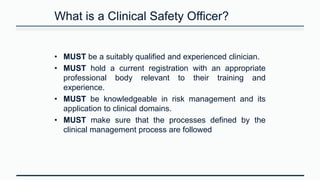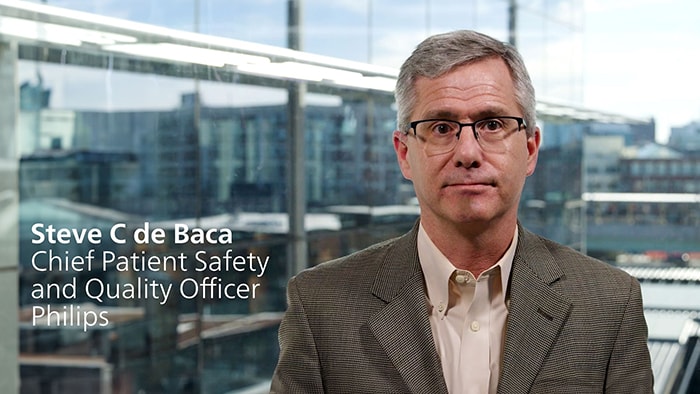Clinical Safety Officer: The Key to Maintaining Safe and Effective Clinical Environments
Clinical Safety Officer: The Key to Maintaining Safe and Effective Clinical Environments
Blog Article
Top Obligations of a Clinical Safety And Security Officer in Modern Health Care
In the progressing landscape of contemporary medical care, the function of a Clinical Safety and security Officer has actually become progressively critical. These specialists are tasked with systematically recognizing and handling scientific threats, yet their obligations expand much beyond simple oversight. From establishing comprehensive security procedures to cultivating a society of safety and security within healthcare teams, their influence is extensive. As they navigate the complexities of regulative conformity and personnel training, one need to consider how these efforts directly affect patient care end results. What are the underlying challenges they encounter in this complex duty, and how can they be efficiently addressed?
Risk Assessment and Administration

The CSO teams up with multidisciplinary groups to collect information on occurrences and near misses, facilitating a society of transparency and continuous enhancement. By assessing patterns and trends, the CSO can determine locations needing intervention, ultimately minimizing the possibility of damaging events. Moreover, the CSO ensures compliance with regulative criteria and standards, which serve to enhance patient security and decrease liability threats.
Effective interaction is crucial; the CSO has to convey risk searchings for to stakeholders, consisting of health care patients, managers, and carriers. Furthermore, the CSO has to remain abreast of emerging dangers connected with new modern technologies and treatment techniques, adapting danger management approaches accordingly. Ultimately, by cultivating a setting of aggressive danger management, the Professional Security Officer adds substantially to the overall safety and security and quality of treatment delivered within health care setups.
Establishing Security Methods

In cooperation with multidisciplinary teams, the Clinical Safety and security Police officer examines data from occurrence reports and take the chance of evaluations to educate protocol growth. This includes establishing clear, workable treatments for various situations, such as infection control, medicine administration, and emergency situation response. Guaranteeing that procedures are not just reliable yet additionally sensible is necessary; they have to be conveniently understood and integrated right into daily operations.
Additionally, the Medical Safety Policeman stays updated on the most recent improvements in security steps and healthcare technologies, adjusting methods appropriately. Normal evaluations and updates of these procedures are required to ensure they remain efficient and pertinent in resolving emerging risks. Ultimately, well-developed safety and security procedures act as a structure for a culture of safety, cultivating an atmosphere where person care is prioritized and dangers are systematically mitigated.
Carrying Out Educating Sessions
While security procedures offer the structure for threat management, carrying out effective training sessions is necessary to make sure that all healthcare personnel are competent in these methods. A Clinical Security Police officer plays a crucial role in establishing and implementing comprehensive training programs tailored to the particular demands of numerous teams within the health care setting. This includes organizing workshops, workshops, and hands-on training that resolve existing safety and security criteria, emergency situation treatments, and making use of safety equipment.
Additionally, the Clinical Safety and security Police officer need to examine the knowledge voids among employee, making sure that training sessions are interesting and relevant. Employing a mix of educational techniques, such as interactive simulations and study, can boost understanding and retention. Clinical safety officer. Consistently arranged training refresher courses also strengthen staff preparedness and adaptability to advancing safety procedures
In addition, promoting a society of safety and security within the company is important. The Professional Safety Policeman need to encourage open dialogue and feedback during training sessions, enabling team to voice concerns and share experiences. Ultimately, well-conducted training try this out sessions equip health care specialists to react properly to prospective dangers, promoting a much safer environment for both people and personnel.
Tracking Compliance Standards
Monitoring compliance standards is integral to the duty of a Medical Security Policeman, making certain that all safety procedures are continually adhered to throughout the healthcare center. This responsibility entails routine assessments of scientific techniques, plans, and procedures to straighten them with recognized regulative and business criteria.
The Medical Safety and security Officer need to conduct organized audits and reviews to recognize potential spaces in compliance, fostering a positive strategy to client safety and security. By implementing durable surveillance systems, the officer can successfully track adherence to safety and security procedures and swiftly address any type of variances.
Furthermore, the Scientific Safety and security Policeman collaborates with numerous departments to guarantee that all team member are conscious of and comprehend compliance demands. This includes analyzing case records, examining risk administration methods, and giving feedback to boost practices.
Additionally, the policeman needs to stay upgraded on advancing healthcare guidelines and criteria, ensuring that the facility adapts appropriately. By cultivating a culture of responsibility, the Scientific Safety Policeman plays a vital role in boosting the overall security and quality of care delivered to people, ultimately adding to better wellness end results and organizational stability.

Promoting a Culture of Safety
Creating a society of safety and security within a health care facility is vital for improving and reducing threats client treatment. A Scientific Safety And Security Policeman (CSO) plays a pivotal function in promoting this atmosphere by read more promoting liability, openness, and constant renovation among staff in any way degrees. The CSO creates and applies security procedures that motivate open interaction and reporting of events without worry of retribution.
To properly advertise a culture of safety, the CSO needs to involve in regular training sessions that stress the relevance of patient safety and risk administration. These sessions should consist of real-life case research studies and simulations to aid team identify prospective threats and recognize their obligations in minimizing them. Additionally, the CSO must help with interdisciplinary cooperation, ensuring that all divisions collaborate to address security problems adequately.
Regular evaluations and feedback systems are vital components of this society. The CSO must analyze security information, identify patterns, and share findings with the entire company to drive renovation efforts. By prioritizing security, the CSO grows a setting where staff really feel empowered to support for their people, leading to boosted treatment top quality and eventually, far better health end results.
Conclusion
Finally, the function of a Scientific Security Officer is essential to cultivating a risk-free healthcare environment. By systematically recognizing clinical risks, creating thorough safety methods, and conducting specialized training, these specialists improve personnel preparedness and compliance with governing standards. Promoting a society of safety and security through open communication and interdisciplinary partnership dramatically adds to enhanced individual treatment. Inevitably, the efforts of Professional Safety and security Officers make sure that security stays a critical focus within healthcare setups.
Eventually, by promoting an atmosphere of positive danger administration, the Medical Safety and security Policeman adds considerably to the overall safety and security and high quality of care provided within healthcare settings.
Furthermore, the Medical Security Police officer stays updated on the most recent innovations in safety procedures and health care modern technologies, adjusting protocols accordingly. Inevitably, strong safety and security methods offer as a foundation for a society of safety, cultivating a setting where individual care is focused on and threats are systematically reduced.
To effectively promote a society of safety, the CSO has to involve in routine training sessions that emphasize the importance of person safety and security and risk management (Clinical safety officer). Ultimately, the initiatives of Professional Safety Policemans ensure that safety and security continues to be see here a critical focus within medical care settings
Report this page